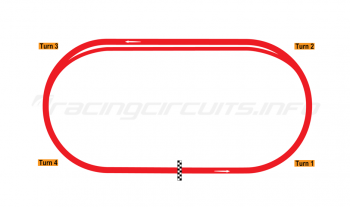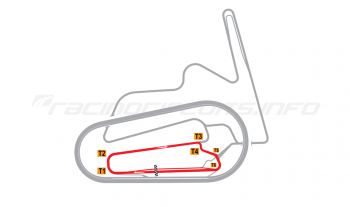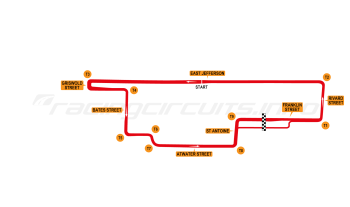Darlington Raceway
Circuit Overview
Darlington Raceway's unusual egg-shaped oval has become a staple of the NASCAR calendar since its inception in 1950, earning itself the nicknames "The Lady in Black" and "The Track Too Tough to Tame".
Its unusual design necessitated by the location of a neighbouring minnow pond whose owner refused to relocate, leading to a lap which is difficult to set up for, each end have often competing demands.
The circuit is also host to the Darlington Raceway Stock Car Museum, which focuses on the history of the circuit and stock car racing more generally.
Circuit History
When Harold Brasington came back from the 1933 Indianapolis 500 and declared that he wanted to build a superspeedway in rural South Carolina, his friends and family thought it was an elaborate joke at best and utterly ridiculous at worst. Then he purchased an old cotton field and they thought he might be insane. Undeterred, the former dirt track racer had the vision and determination to make a far-fetched dream a reality.
Correctly calculating that the new sport of stock car racing was on the ascendancy, Brasington gambled on being able to attract a race if he built a circuit. Working at his trademark small desk at home, he drew up plans for the new superspeedway. Speaking in 1993, he said his aim was to create an everyman's track: "I wanted a race where a local grocer, mechanic or baker could driver their car off the street and compete with their neighbour."
Originally, he envisaged a standard oval, but there was a problem; the farmer who sold Brasington the land operated an adjacent pond where he farmed minnows. Part of the deal was that any track should not disturb his fish, so Brasington was forced to modify his design to create one corner tighter and narrower than the other, taking up less space and moving it further away from Sherman Ramsey's pond. By such a quirk of fate came the circuit layout which would go on to torment drivers and engineers in equal measures down the years, as they seek an ideal setup which probably never existed. Darlington has always been about compromises.
Construction begins on 'Harold's Folly'
Beginning in 1949, Brasington and his workers toiled to complete the facility, Harold himself taking the controls of the diggers on occasion, often to the chagrin of the workers! After nearly a year, 'Harold's Folly' was complete and the 1.25 mile oval was ready for racing. Brasington's gamble looked to have paid off as a deal was secured that summer with Bill France Sr to host a 500-mile NASCAR race on Labor Day, 1950. A two-week qualifying format, similar to Indianapolis, was planned to accommodate the 75 entrants who took part. The crowds were there in numbers too; 25,000 showed up on race day, more than double the expected number, overwhelming the grandstands and crowding onto the interior of the oval, instantly creating the infield culture which remains a feature to this day.
The inaugural Southern 500 proved to be a test for both drivers and machinery, for many being their first all-asphalt race. Californian Johnny Mantz had an unusual strategic plan, thanks to superior tyres; Mantz had correctly calculated that car tyres wouldn't last, so fitted much slower but more durable truck tyres, qualifying last. As the six hour race unfolded, despite driving slowly around the apron Mantz rose through the field to the lead as one by one his competitors pitted for new rubber. So bad were the tyre problems, crew chiefs were seen frantically buying tyres from spectators in the infield to keep their cars in the race. Mantz didn't even require a tyre change and motored to victory, setting a record for most places gained en route to victory which is unlikely to ever be beaten.
Did you know?
Darlington has had more than an few unusual quirks during its long history:
- The infield used to be home to 'The Blockhouse', a cinderblock jail for drunks.
- With only one hotel in Darlington during the race's early years, fans came the night before and slept on the bonnets of cars around the town square. Some Darlington homes took in fans, setting up makeshift beds in front rooms.
- To put down rubber to help traction on the track, townspeople were urged to drive their cars on it in the days before the race.
The pattern was thus set from the very first race that victory would always be hard-earned at Darlington. The track soon became a favourite with the drivers, partly due to its difficulty, partly due to its long length compared to other ovals of the era and in no small part due to its ambience. Darlington was the place a stock car driver wanted to win and the Southern 500 soon became a season highlight.
The only thing the circuit lacked was high speed; the narrowness of the racing groove allied to the relatively shallow banking of the final two turns resulted in average speeds which barely crept above 75 mph. At the end of 1952, the circuit was reconstructed with steeper banking in turns three and four, greatly increasing the speed. The reconfigured circuit was remeasured under a new system, which took the track length from the banking rather than the apron, leading to a new official lap length of 1.366 miles.
Bob Colvin takes the helm
Having set his circuit on a firm footing, Brasington sold his shares in Darlington in 1953 and legendary promoter Bob Colvin was installed as President and General Manager. Under Colvin's leadership the track continued to thrive. Brasington would go on to assist in the design of Charlotte Motor Speedway before building his second track, Rockingham in North Carolina.
As Darlington became established on the NASCAR trail, the list of winners at its two events read like a "who's who" of stock car racing:- Richard Petty, Cale Yarborough, David Pearson, Buddy Baker, Bobby Allison, Fred Lorenzen, Fireball Roberts, Joe Weatherly all took victory here. Weatherly would go on to be honoured by the circuit in 1965, with the opening of a museum in his name which celebrates the history of stock car racing. Weatherly had suggested Colvin should build such a facility shortly before his death during a race at Riverside.
A tragic accident in 1960 ultimately prompted a new safety innovation; during the Southern 500, the leading car of Bobby Johns tangled with Roy Tyner's, turning Johns onto his roof and sending the car into the inside pit wall. The wall broke on impact and debris went into the pit area, killing a car owner, a mechanic and a NASCAR official. Two more people were critically injured, another seriously. For the following year, retaining walls were erected in front of both pit areas (a secondary pits have been established along the backstretch) to prevent such a tragedy occurring again.
Into the 1980s, Darlington continued to have the allure of old, but its facilities certainly lack the lustre of the early days. International Speedway Corporation bought the rather worn-down facility in 1982, but aside from alterations to the pits entry and exits in 1985, little changed at the South Carolina facility. A standing joke in NASCAR circles was that if a tornado hit the facility, it would do $5 million of improvements...
Darlington is modernised, bit-by-bit
That all changed with the appointment of Jim Hunter as track president in 1993. His aim was to transform Darlington into the Augusta National of stock car racing. While that lofty ambition would ultimately prove unachievable, Hunter persisted in pestering ISC bosses for money for renovations and, bit by bit, improvements began. In 1994 Tyler Tower opened adding an additional 15,966 seats to the famed track and the Pearson Tower was added in 1998, named after all-time Darlington Raceway wins leader, David Pearson.
The biggest change came in 1997, when the decision was made to switch the start/finish to the back straight, to allow for the creation of a larger main grandstand. Old hands at Darlington would spend the next few years confusing themselves with the corner names, which naturally also had to switch over, the old Turn One becoming the new Turn Four and so on. In 1999, the circuit added additional pits stalls to its front stretch grandstands, allowing it to discontinue using secondary pits on the backstretch.
Hunter returned to ISC headquarters in 2001 but the investments continued. From late 2003 to early 2004 lights were installed for night racing, providing relief to drivers and crews from the usual scorching heat during races. In 2005 SAFER barriers were fitted, then in 2007 the track received the largest injection of funding since it was created, with ISC authorising $10 million of upgrades. These included repaving of the racing surface and aprons and the addition of concrete pit stalls. A new infield access tunnel, large enough to accommodate race car haulers as well as motorhomes, was also constructed at the west end of the track.
Jump onboard
Circuit info
- Darlington Raceway, 1301 Harry Byrd Highway, Darlington, SC 29532, USA
- +1 843 395 8900
- Email the circuit
- Official website
Rate This Circuit
Votes: 8114
Plan a visit
Get your race tickets!
Brought to you with: 
We've teamed up with Motorsports Tickets to bring you the best deals for Formula One, MotoGP, Le Mans and more.















